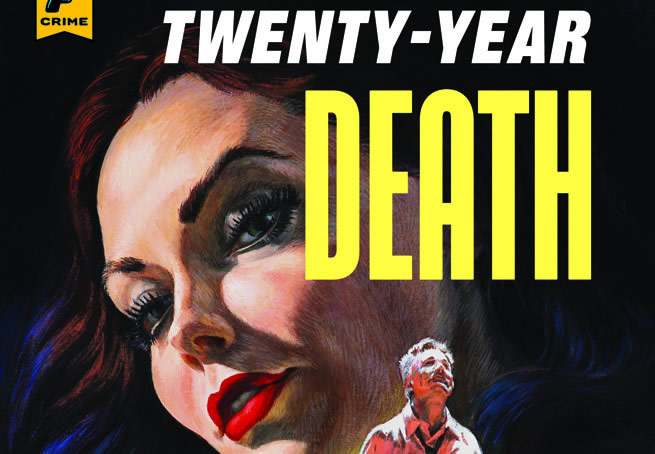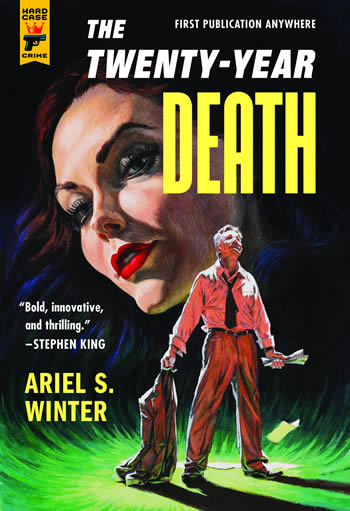Craft
Mystery Invites Stylists:
Ariel S. Winter and The Twenty-Year Death

 riel S. Winter is the author of The Twenty-Year Death, a pulp mystery pastiche comprised of three novels, in each of which he imitates the style of a different giant of the genre: Georges Simenon, Raymond Chandler, and Jim Thompson. The 700-page tome is just out from Hard Case Crime, an imprint "dedicated to reviving the vigor and excitement, the suspense and thrills—the sheer entertainment—of the golden age of paperback crime novels, both by bringing back into print the best work of the pulp era and by introducing readers to new work by some of today's most powerful writers and artists." Winter is previously the author of the picture book One of a Kind, and the blog We Too Were Children, Mr. Barrie, devoted to the rediscovery of children’s books written by literary icons.
riel S. Winter is the author of The Twenty-Year Death, a pulp mystery pastiche comprised of three novels, in each of which he imitates the style of a different giant of the genre: Georges Simenon, Raymond Chandler, and Jim Thompson. The 700-page tome is just out from Hard Case Crime, an imprint "dedicated to reviving the vigor and excitement, the suspense and thrills—the sheer entertainment—of the golden age of paperback crime novels, both by bringing back into print the best work of the pulp era and by introducing readers to new work by some of today's most powerful writers and artists." Winter is previously the author of the picture book One of a Kind, and the blog We Too Were Children, Mr. Barrie, devoted to the rediscovery of children’s books written by literary icons.
PROPELLER: What about mystery makes it a good candidate for pastiche?
ARIEL S. WINTER: Mystery is very stylized. It has conventions in a way that other genres don't, in part because of the natural flow of the story. There's a crime, there's an investigation, there's a solution. That rigid structure gives stylists a lot of latitude, so that the greats in the genre, from Poe to Doyle to Christie to Hammett, each sound so different. And it's stylists that invite pastiche in any genre. Faulkner, Hemingway, Pynchon—these are authors that are fun to do, because they excite us with their language. Sci-fi and fantasy have conventions, but they're more about world building than language. When you do Tolkien, you do your own Middle Earth. When you do space, you may have Asimov and Bradbury and Clarke there with you, but it's the feeling of space more than anything. Romance might have the same rigid structure (boy meets girl, courtship, fulfillment), but for whatever reason you don't have the same distinct stylistic flourishes that mystery seems to. (I'm not up on my romance, so I might be wrong about that, but that's my sense. I know the big-selling names, but nobody talks about what they sound like.) So the question might not be why mystery invites pastiche, but why mystery invites stylists.

PROPELLER: Why these particular stylists?
ARIEL S. WINTER: I chose Simenon for no better reason than I was reading a lot of Simenon at the time. The Maigret novels, while not formulaic, felt manageable. They're all about 120 pages, relatively short chapters, and strong on mood. My Simenon-style book ended up getting expanded to twice the length of a normal Maigret in the end, but my first draft was novella length with a parlor-room-style ending. The idea to expand the book started with the question, What would a mystery series look like if we followed a character other than the detective from book to book? Since I had started with a pastiche, I liked the idea of one character wandering through a sort of history of the mystery. Chandler made sense for the main character, who in the first book is an American writer living in France. Most of the writers who did that ended up writing for Hollywood at one time or another, so it was natural for the character to move to Chandler's L.A. I chose Jim Thompson for the third book for several reasons. There were ten years between the events in the first two books, as Simenon wrote in the 1930s and Chandler in the 1940s. The idea wasn't simply that the character would move from stylist to stylist, but that as his life progressed, it would be told in the voice of the stylist in that period of his life. So with ten years between the first two books, I wanted another ten years to pass between book two and three, which put us in the 1950s. I'm a big Jim Thompson fan, so I was predisposed to use him, and he fit the time period. Also, as the character's life falls apart, Thompson's first person narrator allowed the main character to narrate the final book and to become completely unhinged, which was necessary for his story arc.
 PROPELLER: How did you negotiate integrating the other writers’ voices with your own? Did one or another pose particular challenges in that regard?
PROPELLER: How did you negotiate integrating the other writers’ voices with your own? Did one or another pose particular challenges in that regard?
ARIEL S. WINTER: I did my best to hold the sound of an author's voice in my head as I wrote. As long as it sounded like Simenon or Chandler or Thompson in my head, I figured I was okay. But, at the end of the day, I was the one doing the actual writing, so my voice was still in it along with the others. When I was rewriting, I might read a passage I'd written another day, and it wouldn't sound like the other author to me at all anymore. So I knew my voice was in there. The bigger concern was whether it sounded like the other authors. As to whether one was more difficult than another, I don't think so. Not in the original writing. I know my editor made the most changes in the Chandler section, so that one was probably harder to pull off, although I didn't feel it at the time.
PROPELLER: The Twenty-Year Death is quite a bit longer than its genre forebears. Did this create any special framing problems, and if so, how did you approach them?
ARIEL S. WINTER: Since I wanted each book to read like a stand-alone, I was always working within the genre's more traditional page length. So, when you see the book on the shelf, it looks massive, but when I was writing it, I was never working with more than two-hundred-fifty pages or so at a time, and the pacing was consistent with that length.
I've been trying to articulate exactly what I think is the most important part of The Twenty-Year Death. Let me give it another go. One of the main things the modernists brought to literature from painting was the use of multi-perspectives for a single incident. Virginia Woolf, William Faulkner, James Joyce all have works in which we see events through the lens of many different characters. In The Twenty-Year Death I tried to turn this inside out to some degree. Instead of one event from multiple characters' perspectives, I have one character from multiple literary voice's perspectives. That is to say, if you imagine Shem Rosenkrantz as a real person, and you imagine multiple writers writing about this real person, which writer's depiction would be accurate? And if those writers were stylists and genre authors whose characters usually border on caricature, which depiction would create in the reader the most fully-rounded person that most closely approximates the real Shem Rosenkrantz? By seeing the same person through the lenses of Simenon, Chandler, and Thompson, it highlights how not real the characters are in their own works, and it also helps us understand how we conceive of a person we've read about in a book. That's some of what I was trying to do in The Twenty-Year Death.
I have an earlier novel that in previous incarnations also had a three-part structure—in this case seeing the same events over and over through the eyes of different characters—that I am rewriting. It's about a family coming together for the engagement party of the eldest daughter only six weeks after the parents have announced they are getting a divorce. It's the best novel I've written other than The Twenty-Year Death and I'm eager for it to find a home soon.
I also have several picture book scripts written, and several more floating around in my head, which I hope to get out soon as well. So, hopefully, my career as both a picture book writer and novelist will continue in the near future.
 Ariel S. Winter lives in Baltimore, Maryland.
Ariel S. Winter lives in Baltimore, Maryland.


